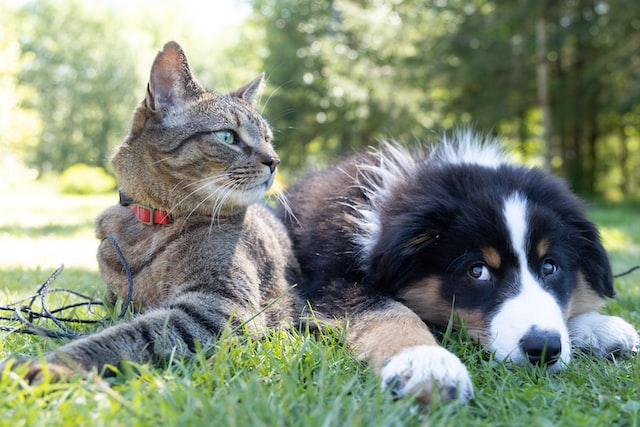Osteoarthritis, spondalosis, and other degenerative bone and joint conditions are common in older dogs and cats. They are, after all, mammals like us, so the fact that they struggle with the same age-related decline should hardly be surprising.
There are other characteristics they also share with us, of which the most advantageous is their ability to benefit from good nutrition. T
o help your furry friends age gracefully without avoidable instances of these painful conditions, keep the following in mind.
Your Pets' Least Favourite Flooring
Before attending to nutritional food and supplements, reduce your pet's chance of hurting its joints while moving around your home. The best flooring for pets is carpeting, which most pets owners do not want to install because of the hair, drool, and occasional accidents.
Sliding around tiles, laminated flooring, and wood can hurt the animal joints, however, especially when it is under a year old and in its middle ages. Because of the lack of traction, their legs can slip away from each other, a bit like a sudden split, or their legs can bend suddenly while they try to get a grip. This can damage their hip, knee, and ankle joints permanently.
If you do not want carpeting all over you home, at least limit the animals' access to the carpeted parts of the house so they do not hurt themselves inadvertently.
Control Your Pets' Weight
Overweight pets are more likely to suffer from joint problems as they age, as their joints must carry weight for which they were not designed. Ask your vet for your pet’s ideal weight and ideal daily calorie intake and use exercise, healthy dieting, and portion control to keep them there throughout their lives.
If you live in an area where you cannot allow your cat to run free safely, train it to walk on a leash. They easily learn to enjoy it.
In general, canned food has more calories than dry food, so the best option for good weight maintenance is to mix some canned food with the dry food so the animal gets the taste of the yummy canned food while still mostly eating the dry food. As the canned food is normally more expensive, this can save you money which you can then spend on a healthy oil to keep your pet’s joints lubricated and comfortable.
It is also important to feed your pets species-appropriate food, as dog food can cause heart disease in cats, for example.
Preservatives, Artificial Colourants, and Stabilisers
To extend the shelf life of pet food, manufacturers include preservatives, colourants, and stabilisers to prevent the food from going rancid. The longer the food lasts, the more of these chemicals it contains.
As fewer studies have been done on the effects of preservatives on pets than on people, the evidence that they are harmful is mixed. But if you prefer to eat few of these in your own diet, you may want to reduce them in your pet's diet too.
To do this, you can either buy food that has natural preservatives (like rosemary, tocopherols and ascorbic acid), or you can buy specialist cooked pet food made by a qualified pet nutritionist, or you can feed your pets the same healthy meat, whole grains, vegetables, fruit, pulses, nuts, and seeds that you eat.
Just be sure to get guidance from a pet nutritionist first if going this route to ensure they get the micro and macro nutrients in the right amounts.
Home-Cooked Pet Food
Many people prefer to cook their pet’s food to avoid artificial chemicals. Just remember that it is probably better for the animals to give them a well balanced diet with preservatives than a poorly balanced home-made diet without preservatives.
Grapes, raisins, onions, raw bread dough (because of the yeast), garlic, chocolates, alcohol, avocados, and macadamia nuts are toxic to dogs and cats.
Several studies that have tested pet foods have found them to be poorly balanced, however, which shows that it is extremely hard to balance your pet’s diets without the help of a trained animal nutritionist. They need proteins, carbohydrates, and fats, like us, but their mineral needs are more complex.
Moreover, feeding them too much of the essential nutrients can cause harm, such as an over-abundance of vitamin A that causes joint pain and an excess of calcium that causes incorrect bone development in dogs.
If you want to cook your pet’s food, first ask an animal nutritionist for recipes. They have been asked the same question numerous times before and many of them have recipes on hand to give you for home cooking.
You can check whether the food agrees with your pet by examining its coat, by checking that it produces faeces around twice a day that is relatively solid, and by making sure it has plenty of energy.
Hydration
To age comfortably, your pets need sufficiently cleaned and purified water to lubricate their joints and to avoid chemical build up that can cause further health problems. Without oil and water, the cartilage between the bones in their joints will erode, which will cause those bones to rub against each other.
Unfortunately, the old saying of being able to lead an animal to water but not being able to make it drink is quite apt here.
You can encourage your animals to consume more water by mixing it with their dry food, by giving them fresh watery fruits as treats, by mixing moist canned food with their dry food, and by pouring some of your healthy vegetable sauces over their food.
Fatty Acids
Like humans, pets need a sufficient amount of omega fatty acids throughout their lives, but especially as they age.
Pets are normally judged to be seniors when they reach half of their life expectancy, which is about six to seven years in large dogs, eight to nine years in small dogs, and eight years in cats. This is the time when you can no longer skimp on essential fatty acids for joint and other organ support.
Remember that animals have evolved to hide when they are in pain to protect themselves from predators. You will, therefore, be unaware that your pet is in pain until long after it starts struggling. By the time it begins to limp or cry, the pain is severe.
This is why it is so important to protect their joints before they start displaying behaviour that indicates discomfort.
A good fatty acid supplement throughout their adulthood, from around their second year, can achieve this. Omega oils have been shown to reduce pain and lameness in arthritic dogs, to be heart healthy, to suppress inflammation, and to improve the quality of their skins and coats.
Specialist Cartilage Support
Various studies on glucosamine supplements have found that they could help build cartilage and reduce pain from age-related worn cartilage in both humans and their pets.
Glucosamine is a crystalline compound that occurs widely in connective tissue. Joint + Hip, one such supplement, also contains chondroitin sulphate, which builds cartilage, hyaluronic acid, which lubricates the joints naturally, and glycosaminoglycans, which suppress the production of inflammatory substances that cause much of the pain and further joint damage.
One review of the scientific literature on supplements containing both Glucosamine chondroitin sulphate showed them to be just as effective as commonly used nonsteroidal anti-inflammatories, without the side effects like kidney toxicity. This can help your pet during the second half of its life when its joints start wearing down and start causing it pain. Its senior years can then be a lot more comfortable.




























Leave a comment